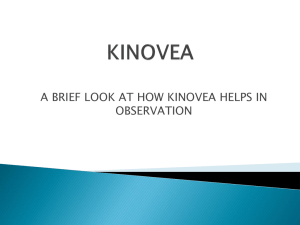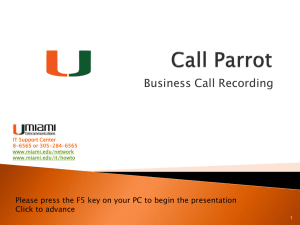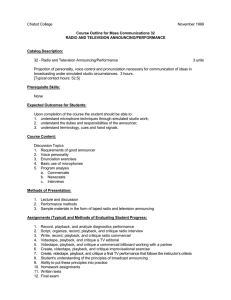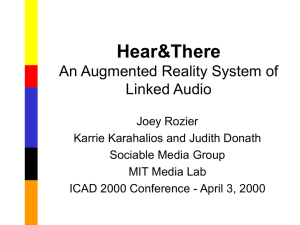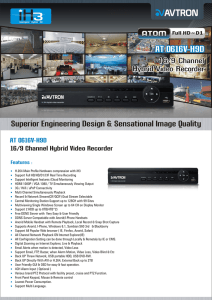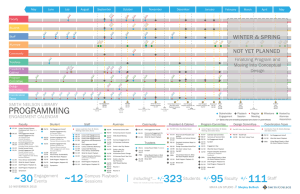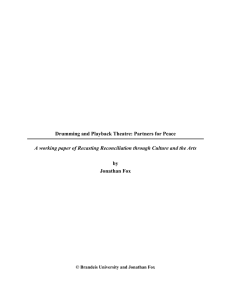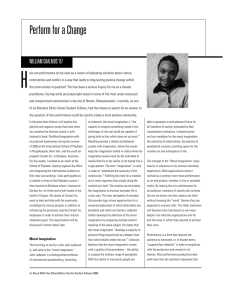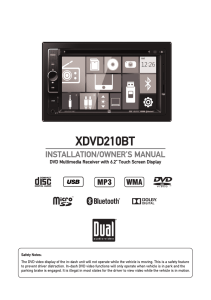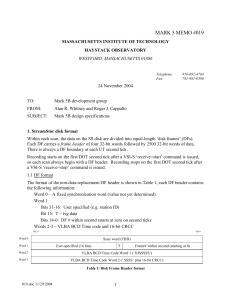REDESIGN PROCESS PROGRAMMING GOALS // BIG PICTURE // Programming
advertisement
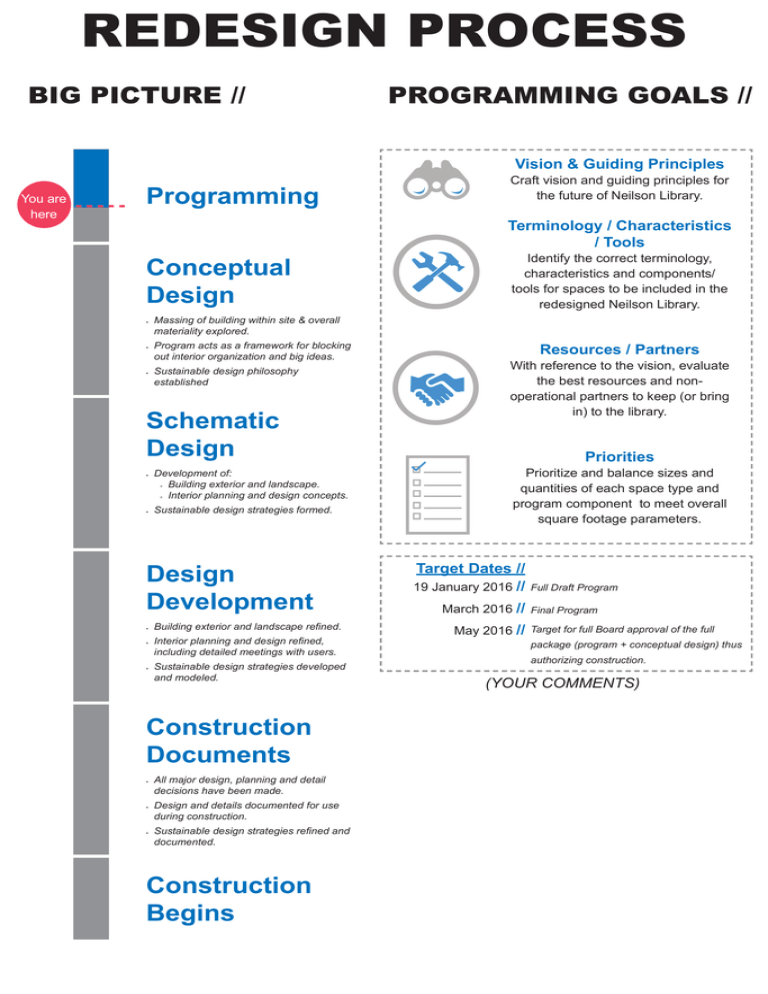
REDESIGN PROCESS BIG PICTURE // PROGRAMMING GOALS // Vision & Guiding Principles You are here Programming Craft vision and guiding principles for the future of Neilson Library. Terminology / Characteristics / Tools Conceptual Design • Massing of building within site & overall materiality explored. • Program acts as a framework for blocking out interior organization and big ideas. • Sustainable design philosophy established Schematic Design • Development of: » Building exterior and landscape. » Interior planning and design concepts. • Sustainable design strategies formed. Design Development • Building exterior and landscape refined. • Interior planning and design refined, including detailed meetings with users. • Sustainable design strategies developed and modeled. Construction Documents • All major design, planning and detail decisions have been made. • Design and details documented for use during construction. • Sustainable design strategies refined and documented. Construction Begins Identify the correct terminology, characteristics and components/ tools for spaces to be included in the redesigned Neilson Library. Resources / Partners With reference to the vision, evaluate the best resources and nonoperational partners to keep (or bring in) to the library. Priorities Prioritize and balance sizes and quantities of each space type and program component to meet overall square footage parameters. Target Dates // 19 January 2016 // March 2016 // May 2016 // Full Draft Program Final Program Target for full Board approval of the full package (program + conceptual design) thus authorizing construction. (YOUR COMMENTS) ENGAGEMENT PROCESS 01 // STUDY + LISTEN Listen Capture Process + Share & Discuss with the Program Committee, Working Groups and Library Leadership to inform their thinking. Playback 01.* • Research to find information VS. research to define a question. Browsability Space Characteristic Categories OPENNESS TECH Building elements should go BEYOND ADA compliance • Don’t move accessible features (signs, ramps, room technology) to the visual margins. Make disability and accessibility • Introduction to resources through class/course curriculum, i.e. – meetings in Rare highly visible FLEXIBILITY It Provides Anonymity It is Inclusive KEY THEMES: Supports academic freedom, by avoiding Accommodates the needs of different • Eliminate any elements that isolate or segregate profiling, maintains privacy through constituencies • The library provides a place to ANONYMOUSLY explore controversial issues and use resources aggregate • Anyone can enter and FIND HELP for various needs • Provide repetition (consistency) as to where things can be found • Where is the map of knowledge? How could browsing be improved? Redesign USE What are the attributes of a WELCOMING Library IMPROVE NAVIGATION: Book Room or Special Collections. should address signage, wayfinding, labeling, grouping of collections. NOISE What we heard about the Role of the Library • Don’t just ensure equal access, but complete access plays into this. SIZE What we heard… What is your research process? User / Study Spaces Working Group It Has Character A Place to Access Collections/Resources Beauty, cozy/Hygge, human touch, Repository of resources for teaching and recognizable, intellectual heart, historical research. Provide the resources that users depth. need in an easily accessible manner. It Promotes Discovery “Librarians are Crucial” Provide opportunities to experience or Libraries house Librarians • Clear wayfinding, labeling ENVIRONMENT: • Displays appeal to all – point to curated collections. • Ability to focus and study/work are affected by a range of environmental factors: Sound/Noise, Temperature, Light • Search process in the library can be intimidating – how could it be made more • Redesign should include both variety for CHOICE and flexibility for PERSONALIZATION RESOURCES: • Basic assistive technology should be found in a range of spaces, but dedicated lab space is also needed, for • Knowledge is open-ended – you need to search for it… • VARIETY, FLEXIBILITY, CONTROL, ADJUSTABILITY, CHOICE • DEMONSTRATE/SHOWCASE DIVERSITY of campus through installations, exhibits, resources type/level, furniture style/adjustability. accessible? • Establish and create transparency for space PROTOCOL • RIGHT SIZING / RIGHT QUANTITY: Open AVAILABLE rooms and terminals, equipment is available for use/check-out learn something new consistent availability, tutoring/consultation/group work. • In thinking of Accessibility – it should not be an EITHER / OR OVERVIEW Theme 02: RESEARCH Theme 07: ACCESSIBILITY *small sampling of material shared on 11/18/15 (YOUR COMMENTS) Theme 02: RESEARCH Theme 06: DIVERSITY ENGAGEMENT PROCESS Synthesis + Detailed Program Work You are here PHASE 03 Synthesis + Program Adjustments PLAYBACK 03 Study + Listen sten PHASE 02 PLAYBACK 02 PHASE 01 PLAYBACK YBA 01 FALL PHASES // CURRENT PHASE 02 // SYNTHESIS + DETAILED PROGRAM WORK Detailed processing, discussion, digestion. Includes: • Analysis of detailed deliverables from each working group • Review of Brightspot’s conclusions • Assessment & Incorporation of comments, drivers, priorities shared during Engagement sessions Drafting of output + framework begins. Includes: • Evolution of Vision based on above + guiding principles clarifying over arching priorities and themes • Terminology/ Taxonomy or identification of elements that need further exploration • Potential Resources/partners + evolved criteria for reviewing and considering Playback 02. (today) Sharing of progress of above for comment 03 // SYNTHESIS + PROGRAM ADJUSTMENTS Playback 03. (19 January 2016) • To include Faculty workshop followed by Board of Trustees meeting (01/ 28/16) with full draft program playback. • Post-January: Final phase for Program Committee to reflect on feedback on draft, prior to finalizing. (YOUR COMMENTS)
